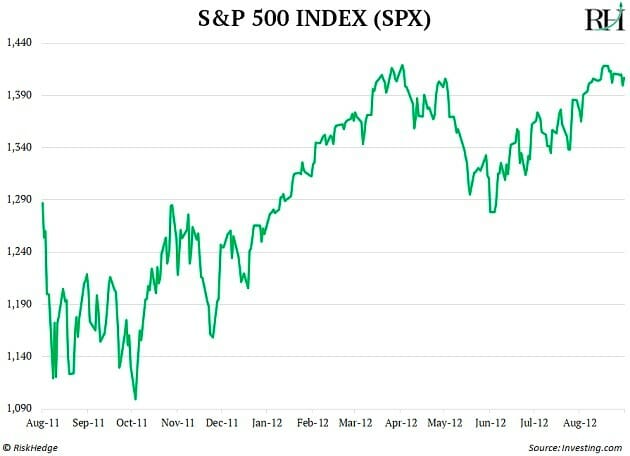The US government is running out of money… Washington politicians are in a standoff… Is a big dip coming?… Remember this quote over the coming months…
Financial Markets Will Hit A Brick A Wall
- Warning: Don’t expect this “new year” stock market rally to last…
Markets are about to hit a brick wall.
Now, you should know many of my RiskHedge colleagues disagree with my take.
Q4 2022 hedge fund letters, conferences and more
But my reasoning is simple:
We’re headed for one of the fiercest political standoffs in recent memory. I believe it will temporarily rock financial markets.
It all has to do with the “debt ceiling” debate. Let me explain...
As an Irishman, I can tell you America does lots of things “bigger and better.”
The hospitality is better, so too are the barbeques. Your cars are bigger. US politicians also do “spending other people’s money” bigger and better than anyone else.
Last year, Uncle Sam spent $6.7 trillion.
The US government spends a lot more than it collects in taxes. It funds the gap by borrowing money. And wouldn’t you know, America is bigger and better at that too.
The US national debt just passed $30 trillion. Some folks think there’s no limit to how much money politicians can spend, but there is.
The “debt ceiling” is a self-imposed limit on how much money Uncle Sam can borrow. We recently hit the $31.4 trillion limit.
Now Republicans and Democrats are tooling up for a standoff about whether to raise the debt ceiling or not.
What This Means For Your Portfolio
- Here’s what this standoff means for your portfolio…
Debt ceiling battles are nothing new in Washington.
Congress has had to raise the limit 75 times since 1960. Most of the time, it’s just political theater.
Republicans and Democrats argue for a couple weeks and then come up with a plan, which allows both sides to spend more of your money.
But once every decade or so, the debt ceiling becomes a huge issue that dominates the headlines.
It last happened in 2011 when President Obama faced off with a Republican-controlled House. Congress raised the borrowing limit just two days before the US government was set to default.
The idea that the almighty US government wouldn’t pay its bills rattled markets. The S&P 500 fell 17% in the months leading up to the deadline.

Isn’t it funny how politicians argued over raising the debt limit to $15 trillion only a decade ago… yet the US national debt has more than doubled since then?
Now the US government has maxed out its credit card once again. And I’m predicting a repeat of 2011.
That’s because the current political situation most closely resembles 2011. Democrats control the White House, but Republicans hold sway in Congress.
Prepare for a barrage of news articles about an impending government shutdown—and how Uncle Sam is just weeks away from defaulting on his debt.
Most important of all, prepare for a stock market correction as the debt ceiling drama heats up.
You’re not hearing much about it now, because the government still has cash on hand to pay the bills. But by the summertime, it’ll be running low on funds... and this will be the most hotly debated issue in finance.
How To Invest
- Okay Stephen, tell me how to invest…
I expect the “game of chicken” over the debt ceiling to roll on for a few months.
But when push comes to shove, politicians will vote to allow themselves to spend more money. Remember, Congress has raised the limit 75 times since 1960. They’re guaranteed to kick the can down the road once again.
However, just like last time, I expect stocks will dip before we get a resolution.
Does that mean you should sell everything now? Absolutely not.
In fact, I recommend buying your favorite stocks on any weakness.
I’m a long-term investor. And while the debt ceiling drama might drive markets over the coming months… that doesn’t matter if you’re investing on a multiyear timeframe like me.
Look at how stocks performed after the 2011 debt ceiling drama, for example.
The S&P 500 fell 17% before we got a resolution. Yet it finished 2011 in the green and jumped 13% over the next 12 months.

Debt Ceiling Guidance
- I’ll leave you with my top piece of “debt ceiling” guidance.
Don’t buy into all the negative stories that will be written about how America and the US stock market are in trouble over the next few months.
I fell into this trap as a young, inexperienced investor in 2011. I believed everything the financial media said. I was genuinely convinced the US was in serious trouble—that US markets could crash and never recover.
How wrong was I? US stocks tripled over the next decade and outperformed pretty much every other investment on the planet.
Ignore the financial commentators who will try to scare you out of your portfolio over the next few months. Use any sell-off as an opportunity to buy your favorite stocks at lower prices. Even if you don’t buy, don’t panic-sell your entire portfolio over the debt ceiling.
When I worked in New Zealand, I sat across from a guy who had the famous quote “This too shall pass” stuck to one of his monitors.
Remember that quote as those around you lose their minds over the debt ceiling.
Article by Stephen McBride, Chief Analyst, RiskHedge
3 Breakthrough Stocks Set to Double Your Money in 2022
Get our latest report where we reveal our three favorite stocks that can hand you 100% gains as they disrupt whole industries. Get your free copy here.






